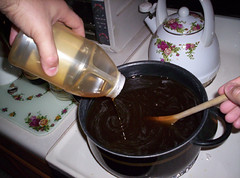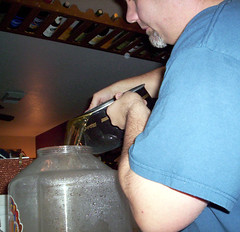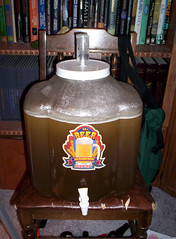
I heated up some water in a large pot (not very hot, but warm enough to make the honey dissolve fairly quickly) then I stirred the honey in. Eighteen pounds worth of honey--that's quite a bit no matter how you look at it. It was just your common clover honey blend you get at any grocery store, because I'm going to make this batch into flavored metheglins and melomels it doesn't make much sense to use the more exotic honeys, such as tupelo or orange blossom. Clover's a fairly "neutral" honey taste, so it lends itself well to experimentation. Then I skimmed off the foam that accumulated on the surface of the heated water/honey mix (removing impurities that could cloud the brew, and some mead enthusiasts would say flavor as well, but again, I'm adding different flavors so it works out).

Because I had so much honey, I had to heat it all up in three separate batches. Once the honey completely dissolved in the water and I finished skimming, I poured the must into the fermentation vessel. Long-time readers (all six of you) may remember my Mr. Beer fermentation vessel from a couple months ago, when it was hard at work fermenting beer for one Mark Finn. The mead making is very similar to homebrewing beer, except I don't add any additional sugar to the mix. The honey supplies all the sugar needed--if the mead is too weak, or too dry, simply add more honey. And yes, I did manage to spill while I was pouring into the fermenter. Must is sticky and obscenely difficult to clean up. I've managed to spill every time I've made mead thus far.

The yeast I'm using is Red Star Pasteur Champagne. I emptied the packet this afternoon in a glass filled with about a cup of warm water. An hour later or so--once the yeasties were happily rehydrated, I filled the glass the rest of the way with non-alcoholic organic apple cider to kick-start their growth and fermentation (honey is rich in sugars but poor in other nutrients yeast needs). I added about a teaspoon of yeast nutrient to the must then pitched the yeast. Starting the yeast with the apple cider did the trick, because the airlock in the fermentation vessel started bubbling almost immediately after I closed it up.
So now I've got six gallons fermenting away. In a month or so, once the fermentation peters out I'll rack the mead into four different secondary vessels--I should have enough for that, if I'm figuring right. The 2.5 gallon fermenter will hold the prickly pear mead, and Lisa wants a mint mead (goodness knows we have enough mint growing through all the flower beds). I'm not sure what else I'll try, but I've been thinking a long time about making a sweet jalapeno mead, so that's a possibility. I've also wanted to try a pecan mead--the oil from the nuts may be a problem, but historically nuts have been used in metheglins. I'm thinking about adding oak chips as well, and probably some tannins to add some punch to the final product. I dunno--I've still got a good while to ponder on this before I have to make a final decision.
Now Playing: Various Songs from the Vaults: A Collection of Rocky Horror Rarities

No comments:
Post a Comment